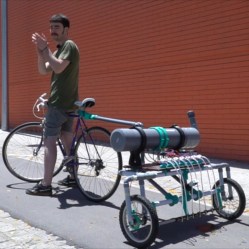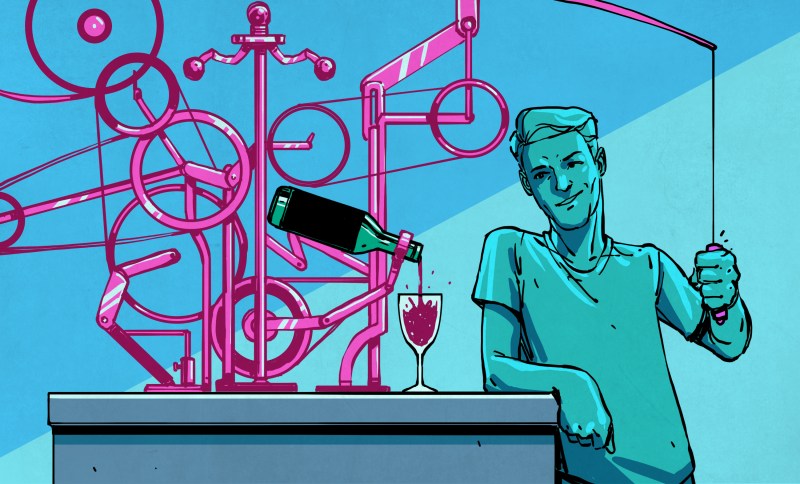How do you come up with new ideas? As much as it sometimes seems like they arrive in a flash out of the blue, they don’t just come out of nowhere. Indeed, we all have well-stocked mental toolboxes that say “this thing can be used to do that” and “if you want to get there, start here”.
One incredibly fertile generator of “new” ideas is simply putting old ideas next to each other and realizing that a chain of two or three can get you to someplace new. It just happened to me while listening to Mike and myself on this week’s Hackaday Podcast.

Here’s the elevator pitch. You take something like the player-pianoesque MIDI barrel piano that we featured last Thursday, and mix it together with the street-painting bicycle trailer that we featured on Friday. What do you get? A roll of paper that can be drawn on by normal kids, rolled up behind a bicycle, with a tank that they can pressurize with a bike pump, that will spray a pixelated version of their art as they roll down the sidewalk.
Now how can I make this real? One of my neighbors has a scrap bike trailer…
But see what I mean about ideas? I just took two existing ideas and rubbed them together, and in this case, they emitted sparks. And I’ve got a mental catalogue of all of the resources around me, some of which fell right into place. This role as fountain of good proto-ideas is why I started reading Hackaday fifteen years ago, and why it’s still a daily must-read for folks like us everywhere. A huge thank you to everyone who’s sharing! Read more Hackaday!
















In the creativity exercises I’ve taught, the synthesis of putting existing things/functions next to one another and bridging the gap gets really interesting when you make that gap very much bigger, creating a void which makes you ask “Why isn’t there *something* that will do _______” even if there aren’t convenient pre-existing concepts to overlap. Granted, when it works as it should, you wind up with a lot of impossiblities, but that’s where the fun really starts!
Cool!
That’s how the Inerter in F1 was born. Finding a hole, and asking what should go there.
Combine the bike and ‘player piano’ ideas, and make what amounts to a music box on the bike trailer. The rear wheels would turn the mechanism, so the faster you pedal the faster it plays. Think of the number of people you could annoy when taking it for a spin. A changeable paper roll with the holes punched for the notes. Or optically read marks on the paper, and kids could mark them and then hear what they’ve done by taking it for a spin.
Or a bike that plays music drawn on the sidewalk with chalk. This could be done with a smartphone app, no trailer required.
Sweet!
Or, just have the chalk squeak like it does on a chalkboard!
B^)
In my experience, most of what we see as original ideas, actually come from old ideas in other disciplines. What to load ballance a network, look at how suitcases are packed. Want to guide a helicopter to a smooth flight and land using only visual ques, bees have the answer. Want to have a dynamic network that eliminates polling, look at magazine subscription services. This is why it is important to be a T shaped person, somebody that has deep understanding of at least one field, and a broad interest and understanding of as wide a selection as possible of others.
T person? Interesting concept… never heard of it before. But i guess most readers here would fall in that category.
This term is popping up for me everywhere in the last couple weeks – last week our dev managers were discussing a the need for ‘T shaped’ teams, with deep knowledge in a couple areas and a smattering of expertise in others.
I’m more of a W shaped person, at least 2 sections with deep knowledge, and not sharp corners but rather gradual loss of depth on nearby skills and knowledge… :)
Well, I thought you were describing the letter “pi”.
But they do just come out of the blue/void, I just see a picture or movie in my mind of the end result accompanied with a sense of what it means, how it works, and how it relates to what I already know. The methodical and conscious part starts with deconstructing that vision of an end result down into the process steps required to fully describe, and so reconstruct or communicate it. In a nutshell the mind diverges, the brain state wave function collapses into a thought (for me often visual), then the mind iteratively converges on the practical realisation. Also I am pretty sure that humans can think about a given problem in more than one way, and they can be radically different approaches too, with the only question being if one is optimal for a given class of problem or if it all comes down to the quality and quantity of how those methods are executed.
Google just had a “talk” from Dr. Franc Ponti on these concepts, the different types of creative thought, and how to blend them for maximum benefit. https://www.youtube.com/watch?v=SZLsI7CtPXM
I’m more of a W shaped person, at least 2 sections with deep knowledge, and not sharp corners but rather gradual loss of depth on nearby skills and knowledge Proteus 8.9 SP3 Crack
I find that one cannot be truly random without a good entropy pool. Therefore I avoid having Cheerios for breakfast in favor of Alpha-Bits.
All of you are likely familiar with the Theory Of Inventive Problem Solving but if not, it’s an interesting concept: https://en.wikipedia.org/wiki/TRIZ
Thanks for the article, Elliot. I can just hear your Podcast voice and phrasings as I read the written words! 😀
This reminds me of the term “bricolage”! It’s all about smashing ideas together, making something creative / new from it, and using available resources to build it. I love using bricolage mindset, though at times it seems to be at odds with the ‘first principles’ mindset. Check it out on Wikipedia for more background (https://en.wikipedia.org/wiki/Bricolage)
Also, slow multi-tasking is interesting for this too. Basically, working on multiple projects at the same time. When you get tired or uninspired from one, switch to another one. Discoveries from either can influence each. Check out this TED talk, where it’s described much more eloquently: (https://www.ted.com/talks/tim_harford_a_powerful_way_to_unleash_your_natural_creativity/transcript?language=en)
this++